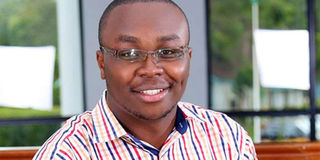Welcome to the world of digital art

What began as a hobby for Jinnah Njue is now a career that has seen him featured in notable international magazines. PHOTO| COURTESY
What you need to know:
- It was at KU that he met the girl who he would later marry.
- He would take numerous pictures of her using his digital camera. One day, a friend suggested that he use Photoshop software to edit the pictures.
- This friend also shared with him video tutorials and magazines that taught him how to use the software.
The essence of an artist is his ability to use paint and brush to pour his soul on canvas. You could say that this is what Jinnah Njue, 24, does, only that the computer screen is his canvas, while digital software techniques are his tools of trade.
He is painting his way into the world of digital art, and his work has not gone unrecognised; international magazines such as Photoshop Creative and Advanced Photoshop have featured his work.
After completing secondary school in 2008, he decided to study a computer-related course, joining Jomo Kenyatta University of Science and Technology (JKUAT) to study computer engineering. Two semesters into the course, he realised that the course centred more on other units and less on the computer intrigues as he had hoped to learn. He switched to Kenyatta University (KU) where he enrolled for a Bachelor’s degree in Fashion, design and marketing.
It was at KU that he met the girl who he would later marry. He would take numerous pictures of her using his digital camera. One day, a friend suggested that he use Photoshop software to edit the pictures. This friend also shared with him video tutorials and magazines that taught him how to use the software.
His interest piqued, he started to read everything he could get his hands on about Photoshop. He and a friend used the WI-FI available at school to download tutorials that would last them a week. There was not a single YouTube tutorial that the two did not master.
With the newly found skills, his biggest challenge was finding a good digital camera that he could use to take high resolution photos that he would later edit. This is how he learnt digital art, which is art created by use of digital software as a core process.
When he was satisfied with his creations, he began uploading them on YouTube. His initial uploads in 2014 received minimal views, but with a few improvements here and there, his breakthrough came after his fourth upload of a speed art named “Lost
aquarium”. This is when Photoshop Creative took note of his work. The magazine is the world’s largest platform for creatives like him. They requested him to showcase his work on their YouTube page, which received over 150,000 views. This was the turning point of his career.
***
It’s true, Practice makes perfect. It took me three years
After being featured by two of the largest creative international magazines, Photoshop Creative and Advanced Photoshop, what impact has this had on your work?
I’ve been contracted by companies abroad on numerous occasions to carry out design and branding work for them. The recognition has also brought with it respect from my peers in the creative industry.
How long did it take you to master digital art?
It took me nearly three years of practice and error to perfect my art. It would have been less had I had all the resources.
What inspires your art?
Nonexistent scenarios. I always try answer the question, “What if?” through my art.
What is the secret to increasing your YouTube views and Subscribers? (www.youtube.com/Jimnah Njue)
The secret is first understanding your target audience and where to access them. Next is branding, having a unique thumbnail. Intro and logo counts a lot in luring viewers to your channel. Finally, consistency. The more content you upload, the more subscribers you gain over time due to having simply demonstrated consistency. In my case, my target audience are my fellow professional creatives who are mostly urban.
How long does it take you to design a piece of digital art?
It’s dependent on the kind of art. On average, it takes me up to five hours for just one piece of art. My preference is in manipulative art, which entails creating an art out of an existent image, simply by using digital software.
What kinds of clientele have you worked with?
I regularly work with Photoshop Creative, Raphtor Graphic and Twine, all from the United Kingdom. Here in Kenya I have worked with several clients, mostly SMEs, NGOs and corporates.
How much do you make on average?
Sh,100,000 a month through my creative agency, Countless Clues, which I set up earlier in the year with my partner.
What are your plans for the future?
I want to grow my creative agency as well as complete my degree next year.




